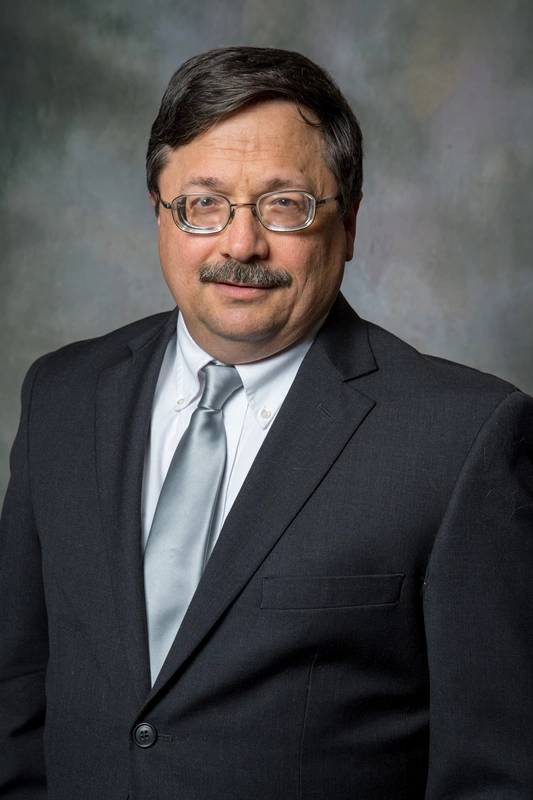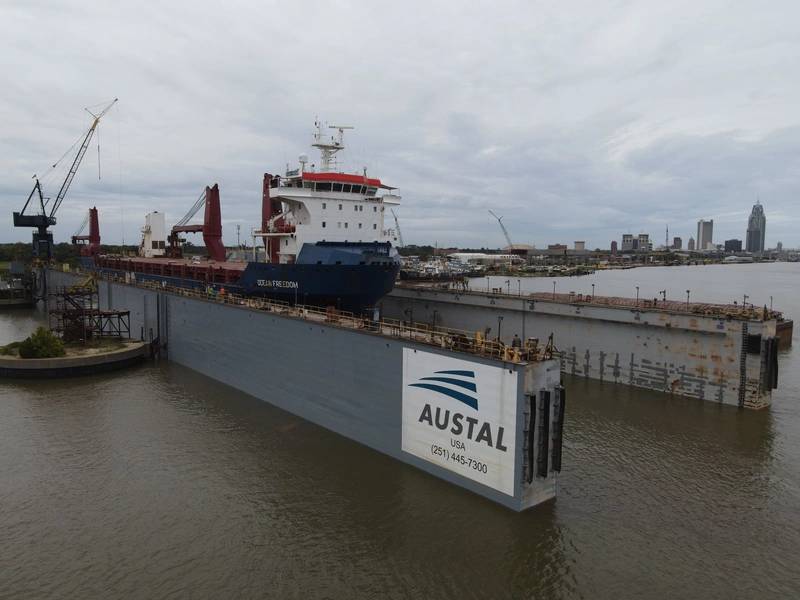



Known best for its construction of U.S. Navy warships, Austal USA in September 2020 acquired waterfront property along the Mobile River and established a commercial ship repair facility. Mike Bell, Austal’s VP Operations and Harley Combs, Director, Austal West Campus Ship Repair discuss the plan.
Austal USA’s long-established shipbuilding facility in Mobile, Ala., is a modern ship manufacturing factory, one of the largest aluminum warship builders in the world producing new ships for the U.S. Navy. But the company is not resting on its laurels, investing mightily in the middle of the pandemic to create both the capacity to build steel ships as well as the opening of a new ship repair facility.
“As part of the overall plan, we wanted to be in control of our own destiny when it came to launching ships, and that’s where West Campus came into play,” said Bell, noting the new drydock that came with the new land purchase. While commercial ship repair is new for the company, Austal USA ops are global like that of its main customer – the U.S. Navy – and today it has a growing facility in San Diego, offices in Singapore and ‘fly away’ teams that are perpetually on the move to service the fleet it has built.
The company’s recent acquisition of property, directly across the Mobile River from Austal USA’s 165-acre corporate headquarters, resulted in the opening of a new home for commercial ship repair in the Gulf of Mexico. At the same time, it is installing a new 100,000 sq. ft. steel panel line at its headquarters, scheduled to open in Q2 2022; a pair of investments that will help drive the company’s business for the next generation.
 "We believe in being vertically integrated, because that allows us to control quality and cost," said Mike Bell, VP Operations, Austal USA. "So, if Harley runs into something (and needs resources) he just makes a phone call."
"We believe in being vertically integrated, because that allows us to control quality and cost," said Mike Bell, VP Operations, Austal USA. "So, if Harley runs into something (and needs resources) he just makes a phone call."
Inside Austal West Campus
Austal’s acquisition included 15 acres of waterfront property spanning almost 3,000 linear feet of waterfront pier space, a 20,000-ton certified Panamax-class floating dry dock, a 300,000 sq. ft. outside fabrication area, and 100,000 sq. ft. of covered fabrication facilities located 30 miles from the Gulf of Mexico.
A big selling point for the new repair yard is its proximity to Austal USA headquarters. “We believe in being vertically integrated, because that allows us to control quality and cost,” said Bell. “So, if Harley runs into something (and needs resources) he just makes a phone call. There happens to be a river between the two campuses. If there wasn’t, you wouldn’t even know that it was a different part of Austal the way it’s set up right now.”
In addition, Combs said Austal USA was able to retain 40 people that had worked at the ship repair facility previously on the premises, a talent-base which gives the Austal USA commercial ship repair upstart immediate credibility and experience. “We have maintained a project management team over here that has been doing this work now for more than 20 years,” said Combs. “I’ve got a couple of them that have more than 30 years of experience. The people that were here were the result of a downsizing over the last few years of the previous company. When we got the people that were left here, we got the best of the best.”
The Austal West Campus repair facility provides access to deep water berthing for vessels up to 1,000 feet, advanced manufacturing capabilities including a friction stir welder, CNC machines, CNC cutting tables, and a carpenter shop, machine shop and electrical and pipe shops. The repair facility also offers heavy-lifting capability with mobile cranes, overhead cranes and wing wall cranes that travel the length of the 668-foot dry dock. The services provided by Austal’s Mobile ship repair operation range from conversions and upgrades to advanced ship repair.
The machine shop and fabrication areas are fully equipped with overhead cranes, lathes, and CNC plasma cutters, and notably it is able to turn shafts up to 55-ft. long on a lathe. Other technical services offered to the company’s service clients include full-service detail design capability, 3D modeling, field engineering support and dimensional accuracy control.
At it headquarters across the river, Austal USA is putting the finishing touches on its new 100,000 sq. ft. steel panel line. “This is geared towards us being a full-blown steel ship construction yard,” said Bell. “We’re the largest aluminum ship builder in the U.S.; probably the largest aluminum warship builder in the world.” But in analyzing the market, Austal USA assessed that the Navy, Coast Guard and Military Sealift Command – “needs somebody like us on the steel side. So we made that investment.” To accommodate the new steel line, Austal will literally split its modular manufacturing facility down the middle. “One side will be kicking out aluminum modules, the other side will be kicking out steel modules,” said Bell.
 The Austal West Campus is a new name in ship repair in Mobile, Ala. Photo courtesy Austal USA
The Austal West Campus is a new name in ship repair in Mobile, Ala. Photo courtesy Austal USA



